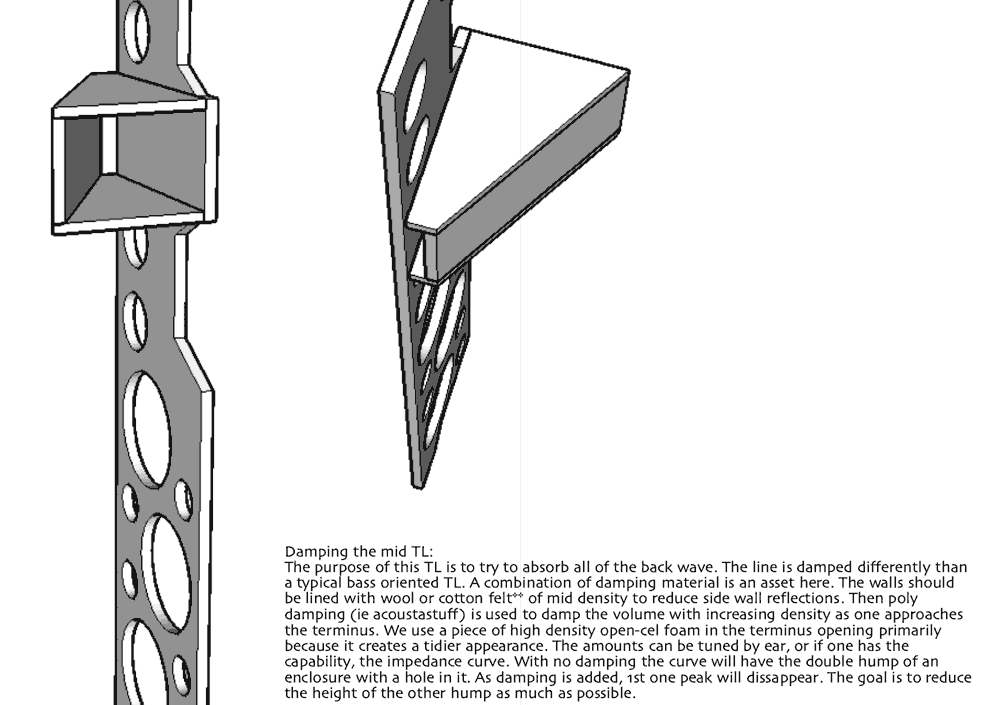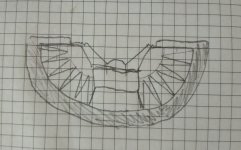kgrlee, do you have any links to a thread or post on the midrange tubes you describe? Would be very interesting to read up on some since it sound like a good solution 🙂
If you have access to some linden / basswood, it has this property that it's possible to blow air through the microscopic tubes. It could be an interesting material for an aperiodic enclosure.
In addition / alternatively, you could use tall wedges to smooth out the impedance change between the air and the solid wall.
From the messy sketch: notice how as the back-wave expands out from the cone, it doesn't encounter a steady low resistance and then suddenly hits a wall. The wedges are like a tapered tube, but you would have to scale your design to be appropriate for the wavelengths that you want to be absorbed.
In addition / alternatively, you could use tall wedges to smooth out the impedance change between the air and the solid wall.
From the messy sketch: notice how as the back-wave expands out from the cone, it doesn't encounter a steady low resistance and then suddenly hits a wall. The wedges are like a tapered tube, but you would have to scale your design to be appropriate for the wavelengths that you want to be absorbed.
Attachments
That was actually a pretty cool idea with the wedges! however it seems like it would be really difficult to produce.
You got me contemplating acquiring a 3d printer just to try out all the crazy ideas haha!
You got me contemplating acquiring a 3d printer just to try out all the crazy ideas haha!
Nothing special about what we and other UK makers used for midrange tubes. I think they were just 4mm cardboard. If you haven't got a cardboard tube supplier, just use plastic drainpipe.kgrlee, do you have any links to a thread or post on the midrange tubes you describe? Would be very interesting to read up on some since it sound like a good solution 🙂
To test the AUDIBLE effect of depth, just try a pot and a tube of the same volume (both stuffed) behind your midrange unit and play pink noise. It's easily apparent. You can try wedges in your pot but I'll bet a LOT of $$$ the long tube will sound better 🙂 You can also do 'waterfalls' bla bla too but a listening test is quick and obvious.
Depends I guess on the app, but a good plan IME here in the Deep South back when relatively inexpensive A/C wasn't common) and the way me n' a few other DIYers in my locale did it (no router) was to use a very rough, half or round wood bastard file to very roughly hog out the backside at an angle (>12 deg included, same as for decaying a really large cab's, room's 'slap echo'). The roughness is good for rapidly decaying any (V) HF emissions, though a little damping material glued/stuffed/whatever is fine for any tapered hole.Say I have a really thick baffle which is thicker than the depth of the tweeter, how deep should you make the cut out for the tweeter? Should I leave some room behind the tweeter in order to "let it breathe" and cool etc or does it not matter much?
Last edited:
Yeah, as already noted, paper towel, TP cardboard tubes are fine and many to choose from at your local Office Suppliers and at least here in the USA at most local Post Offices (AKA mailing tubes).Nothing special about what we and other UK makers used for midrange tubes. I think they were just 4mm cardboard. If you haven't got a cardboard tube supplier, just use plastic drainpipe.
I've got a pair of empty Infinity cabs sitting out on the deck (wife's plant stands...) that have the cardboard tube sub-enclosure for the mids - they go all the way to the back of the cabinet.
What bla bla is there to say about waterfalls? I’d say they should confirm perceived differences.Nothing special about what we and other UK makers used for midrange tubes. I think they were just 4mm cardboard. If you haven't got a cardboard tube supplier, just use plastic drainpipe.
To test the AUDIBLE effect of depth, just try a pot and a tube of the same volume (both stuffed) behind your midrange unit and play pink noise. It's easily apparent. You can try wedges in your pot but I'll bet a LOT of $$$ the long tube will sound better 🙂 You can also do 'waterfalls' bla bla too but a listening test is quick and obvious.
Waterfalls bla bla do not always tell you if the sound is good or not. I once spent some time explaining this to John Atkinson. This was when only KEF and ourselves could do what we called KEFplots (their CDS or da modern waterfall) and PAFplots (after our own Peter A Fryer) But in this case, depth behind a cone midrange, it certainly does confirm what you can easily hear with pink noise 🙂What bla bla is there to say about waterfalls? I’d say they should confirm perceived differences.
I've thought about this topic some more and another question arose regarding the tube approach.
Does the stuffing subtract in any meaningful way from the internal volume? The yellow fiberglass earlier mentioned?
Should you calculate the internal volume first and then stuff or just go for depth, letting the tube span the entire depth of the overall enclosure, and then stuff it as much as possible until a suitable qtc is achieved?
Does the stuffing subtract in any meaningful way from the internal volume? The yellow fiberglass earlier mentioned?
Should you calculate the internal volume first and then stuff or just go for depth, letting the tube span the entire depth of the overall enclosure, and then stuff it as much as possible until a suitable qtc is achieved?
I for one like it! I put that stuff into an acoustic guitar body to see what's heard - between different guitars.you can easily hear with pink noise 🙂
I've got a pair of empty Infinity cabs sitting out on the deck (wife's plant stands...) that have the cardboard tube sub-enclosure for the mids - they go all the way to the back of the cabinet.
Same as the IMF TLS80s. I might still have one of those tubes. 3-4mm cardboard.

In our big MTM i needed a ,idTL that tapered more quickly. So this construction. Much more work than a tube to or thru the back.

I used a piece of 4” PVC plumbing pipe for the AudioNote cabinet s i am repurposing (2 Coral 8” bipolar + a 3” midTweeter [TB W8-871eN at the moment])
And the Halcyon: 8” concrete form tube

A circular cylinder is incredibly stiff 7 easy to implement.
dave
Go for maximum depth. The correct density of stuffing actually INCREASES the effective volume. To do this by the book, youShould you calculate the internal volume first and then stuff or just go for depth, letting the tube span the entire depth of the overall enclosure, and then stuff it as much as possible until a suitable qtc is achieved?
- measure the resonance of the unit in the 'box'.
- start stuffing with Fibreglass. You'll see the resonance DROP
- keep stuffing until the resonance stops dropping. That's usually about the consistency of a cushion. It's not critical. I used to have the optimum density for different stuffing materials but I've lost the info.
Qtc also goes down but you're not usually bothered about this for a midrange. The AUDIBLE benefit is much cleaner midrange which you can test by listening with pink noise .. or even music 😱 or waterfalls bla bla 🙂
Last edited:
Go for maximum depth
Mine are usually open to the air out the back. Stuffing density increases as the terminus is approached.
dave
Glass fiber is said to be a cause of cancer.
Take care.
And read the MSDS of whatever material you choose.
Take care.
And read the MSDS of whatever material you choose.
Glass fiber is said to be a cause of cancer.
If you breath it in, yes.
Fiberglass insulation has gotten “healthier” over time, and people working with it today wear masks.
There is fiberglass insulation that is not itchy, i have some out of some old loudspeakers, and i have pulled out bits where the insulation was in a cloth bag. And real special stuff like angel’s hair.
I use recycled denim insultion when i need this kind of damping.
dave
Thank You for pointing out that alternates exist.
In a damp tropical climate, I would avoid denim, and go for synthetic fibers / pillow fibers / fabric, as denim is cotton fiber based, can spoil.
Temperate areas, no issues.
I deal with people who sometimes do stupid things, and safety here is not seriously enforced, so in general I would avoid a situation where loose fibers can be breathed in, the effects show up much later, difficult to connect cause and effect.
So I tend to avoid using materials and procedures which should be used by trained people with proper equipment.
Some people would say it is just a small bag, no need to wear a mask, or have air filters. And they are DIY, cannot say what they use or will do.
Small rant, at times things happen when they should not have.
In a damp tropical climate, I would avoid denim, and go for synthetic fibers / pillow fibers / fabric, as denim is cotton fiber based, can spoil.
Temperate areas, no issues.
I deal with people who sometimes do stupid things, and safety here is not seriously enforced, so in general I would avoid a situation where loose fibers can be breathed in, the effects show up much later, difficult to connect cause and effect.
So I tend to avoid using materials and procedures which should be used by trained people with proper equipment.
Some people would say it is just a small bag, no need to wear a mask, or have air filters. And they are DIY, cannot say what they use or will do.
Small rant, at times things happen when they should not have.
Duu.uuh ! That should be Isothermal conditions.It drops cos the Fibreglass creates Adiabatic condtions inside. Theoretically, the effective volume can increase by 40% but 20% is more like a practical limit. Fibreglass is a LOT better than polyfill etc for this.
There's only one other material that is as good as nasty Fibreglass for this. It is Dr. Bailey's Long Fibre Wool off the backs of sheep from the Yorkshire Dales. This was used in the first Transmission Line speakers (see Wireless World circa 1965?) & Radford. It is much nicer for the workers stuffing your cabinets but has the disadvantage of being edible to moths. And No. I'm not joking.
synthetic fibers / pillow fibers / fabric
I use acoustastuff in that role. There is a considearble range of properties for various kinds of polyfluff. Zia did some work on what he could source.
dave
- Home
- Loudspeakers
- Multi-Way
- 200mm diameter plastic (polypropylene?) tube for mid enclosure in sealed 3-way

